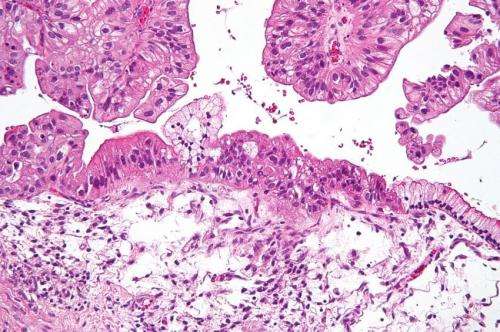Experimental drug combined with standard chemo may shrink ovarian cancers

Working in cell cultures and mice, researchers at Johns Hopkins have found that an experimental drug called fostamatinib combined with the chemotherapy drug paclitaxel may overcome ovarian cancer cells' resistance to paclitaxel.
Scientists elsewhere are already testing fostamatinib in people with lymphoma and idiopathic thrombocytopenia purpura, an autoimmune disorder. Based on results of the current study described in a report online June 18 in the journal Cancer Cell, Johns Hopkins researchers say they are planning a phase I clinical trial to test the paclitaxel-fostamatinib combination therapy in patients with recurrent advanced ovarian cancer. That study is expected to begin this fall. Fostamatinib is not yet approved by the Food and Drug Administration.
Paclitaxel and another chemotherapy drug, carboplatin, are considered standard, first-line treatments for advanced ovarian cancer, experts say, and most patients respond to the drugs initially. However, the majority of patients develop treatment-resistant tumors, and only 10 to 15 percent of these patients survive long term, says Ie-Ming Shih, M.D., Ph.D., the Richard W. TeLinde Distinguished Professor in the department of Gynecology and Obstetrics, who led the study with Tian-Li Wang, Ph.D., an associate professor of pathology and oncology at the Johns Hopkins University School of Medicine. More than 21,000 women are expected to be diagnosed with ovarian cancer this year in the U.S., and more than 14,000 will die from it.
Shih, Wang and their colleagues tested fostamatinib's power to reduce tumor size in mice implanted with human ovarian cancer cells that were resistant to paclitaxel. A combination of fostamatinib and paclitaxel reduced tumor size in six mice by up to 87 percent, compared with no shrinkage in six untreated animals after three weeks. After five weeks, the combination treatment in the six mice decreased tumor size by up to 66 percent, compared with six mice treated with only paclitaxel.
When patients with advanced ovarian cancer become resistant to one drug, clinicians usually prescribe a new drug. But Shih says there are only a few drug options proven effective for treating advanced ovarian cancer, and that patients might be at risk for different or worse side effects after adding a new drug to their regimen.
In a previous study, Shih, Wang and their colleagues found that paclitaxel resistance may occur because of higher levels of an enzyme found in ovarian cancer cells called spleen tyrosine kinase, or SYK. The levels were highest in recurrent tumors compared with matched primary tumors. The Johns Hopkins team confirmed this result in the current Cancer Cell study.
The scientists then analyzed 25 different ovarian cancer cell lines in the laboratory and discovered that the higher the amount of active SYK in the cell lines, the more resistant those cells were to paclitaxel treatment. But when the researchers treated the resistant cells with the SYK inhibitor fostamatinib, they were able to increase the paclitaxel sensitivity of the cells.
Paclitaxel targets a part of the cell's internal skeleton called microtubules and stabilizes the structure so that the cell cannot rapidly grow and divide. Fostamatinib's effect on microtubules seems to increase the stabilizing effect of paclitaxel, even in resistant cells, which in turn may prevent cancer cells from proliferating, says Yu Yu, Ph.D., a postdoctoral fellow at the Johns Hopkins University School of Medicine and co-author of the study.
Based on what is already known about fostamatinib toxicity, Shih says that patients using a combination of fostamatinib and paclitaxel may experience side effects that include low white blood cell counts, nausea, vomiting and diarrhea.
More information: Cancer Cell: DOI: dx.doi.org/10.1016/j.ccell.2015.05.009


















